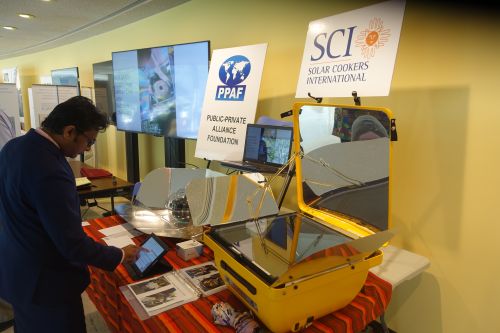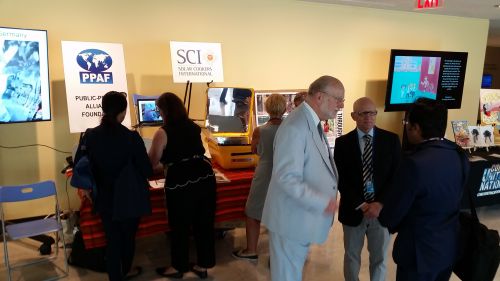
What it’s like representing SCI at the United Nations High Level Political Forum
What it’s like representing SCI at the United Nations High Level Political Forum
By SCI Board Member Wyldon Fishman
With edits by SCI staff
The rare air of the United Nations gushes up to greet me at the steps and through the revolving doors into sanctuary, hope and the magnificence of hundreds of people working on world peace from a whole new standpoint: 17 Sustainable Development Goals (SDGs). The SDGs are a set of guidelines and goals, set in place by the United Nations, to promote peace and prosperity globally. Lifting women out of poverty, fixing oceans and air, education, food security - these are a few of the 17 SDGs you may not have heard about.
"Can you point me to the Japanese Garden at the round wall?" The flags are visible! We aren't down in the basement corridor but situated by the Lobby Café and the office tower escalators so everybody can see our 3 solar cookers. The Sultanate of Oman travelled all the way from the Arabian Peninsula to have a booth next to us, which shows just how these advocacy opportunities arise... it seems too good to be true! As the SCI Volunteer Team arrives, we set up a magical video. In seconds we are positioned in the crossroads of major foot traffic.
About 5 years ago, the 17 SDGs were fine tuned. Three summers ago, SCI's delegation (including SCI Global Advisor Dr. Janak Palta McGilligan) attended our first 2-week High Level Political Forum ("HLPF"). At HLPF, world leaders and advocates from around the world meet for eight days to discuss their countries’ progress towards global peace and prosperity, with a focus on the Sustainable Development Goals set forward by the United Nations. We sat comfortably inside rooms watching the proceedings on a huge screen as 44 countries presented their own progress reports towards healing the planet and promoting equality and peace.
At HLPF this year we were in an exhibit booth with our biodigester and solar cooker partner Private Partnership Alliance Foundation (PPAF). The Education related SDGs were Solar Cookers International and PPAF worked together on a curriculum in Haiti at the Medical and Nursing campus of the University of Notre Dame Hinche.SCI Science Director Alan Bigelow, PhD and Kathy Puffer, lead PPAF teacher. and Kathy Puffer, lead PPAF teacher.
I'm peering at my colleagues who are all experiencing questions from need-to-know staff, delegates and others attending the forum. SCI has set up a paperless sign up and automatic thank you note. Business cards are stapled into a notebook. Flip charts have been edited to perfection (Thanks, Solar Cookers International Associate Mary Buchenic!)
The CooKit showed the new glass bowl greenhouse instead of plastic, which enables the small solar cooker to cook faster and more efficiently. (The United Nations has overhauled their food service to eliminate plastic.) The SunFocus (a hybrid solar/electric cooker) by David Chalker offers the cloudy solution. The newly committed SunFlower lets us explain the solar cooker Performance Evaluation Process (PEP) testing that SCI developed.
The harmful effects of burning wood, massive global deforestation, poor lung health, and expensive charcoal are all good reasons to support solar cooking. SCI’s voice carried this message loud and clear to government leaders and representatives at HLPF at the UN.

